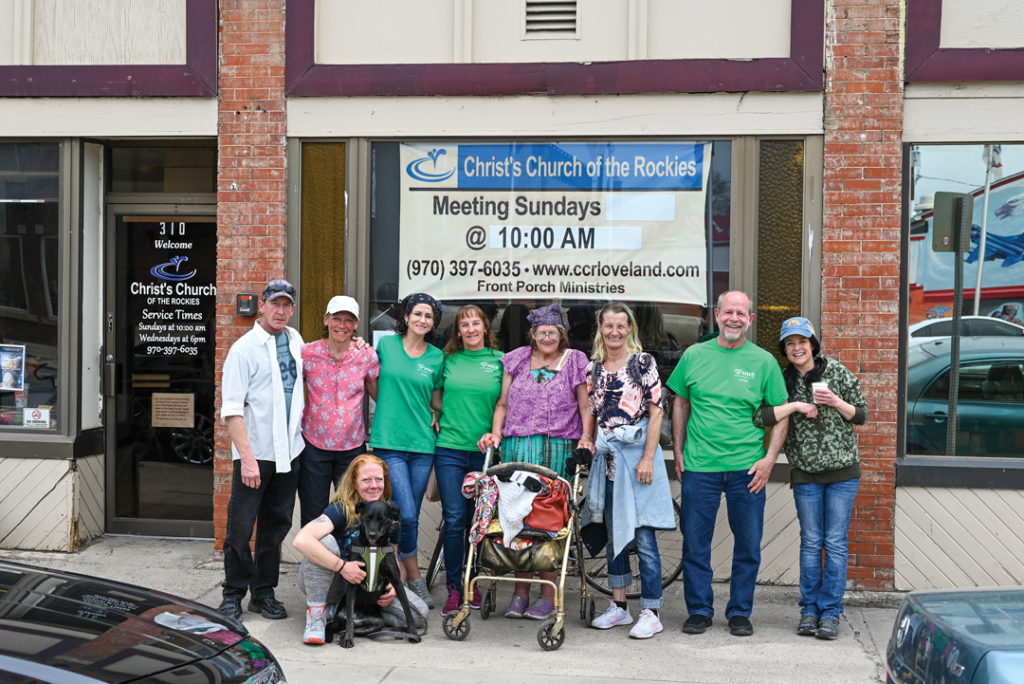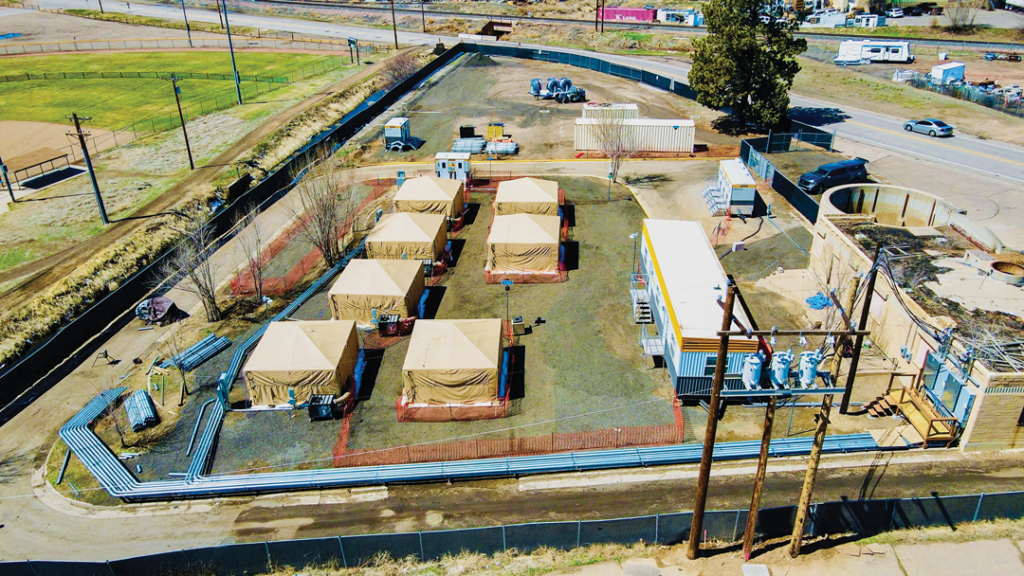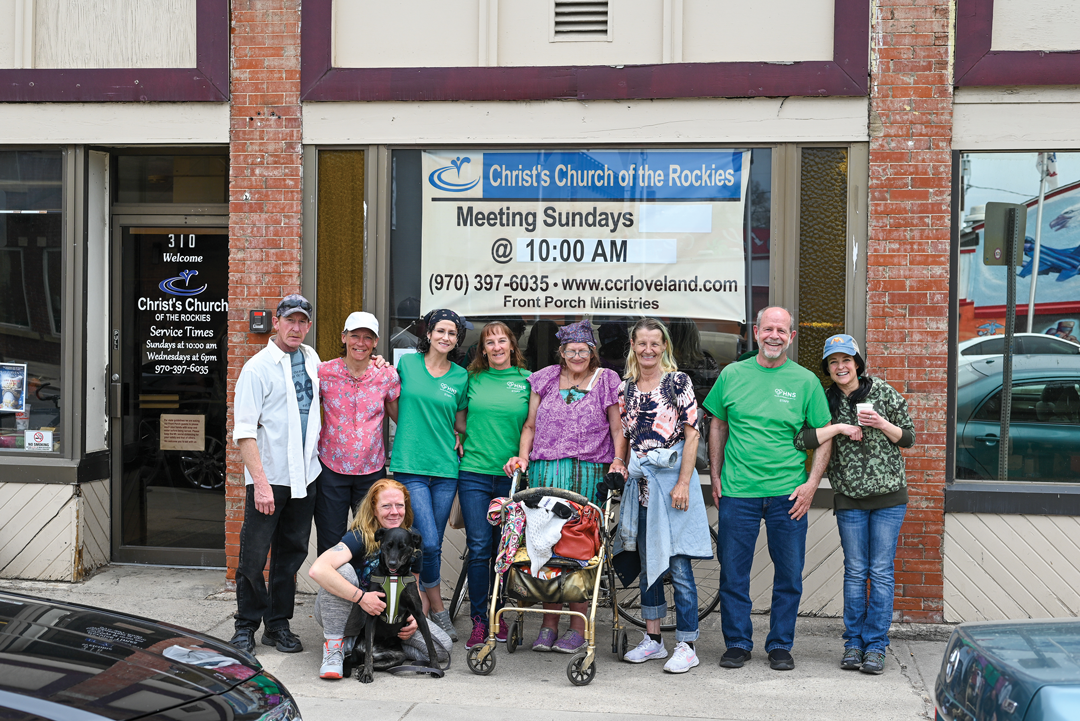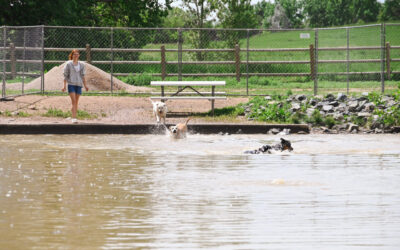One of the first homeless shelters in Loveland was in Doug Ashbaugh’s home.
Ashbaugh has a pro cycling timing business, and for many years, he’d go from one bike race to the next. He’d set up his timing equipment and a sound system for announcing the leaders as they blurred through the criterium. Before the events, when he’d have a little precious downtime, he’d watch the cities prepare by clearing the streets. It began to bother him.
Cities would push people experiencing homelessness off the sidewalks, park benches and curbs and sweep them away like garbage, shooing them off to an alley, a muddy spot by a river or maybe a church if one was kind enough to take them in.
He knew nothing about their lives, but when a friend asked him to get involved in Loveland’s homeless issue, he agreed. Ashbaugh and a few others developed a patchwork system with the help of a church and a couple nonprofits to feed the homeless, give them supplies and find them warm places to sleep.
In 2006, an emergency night shelter was established to keep the homeless safe from the killing cold, but sometimes that made the work harder in the summer when they had nowhere to go. Ashbaugh and others placed them in churches, and at night, when it was his turn to stay with them, he’d listen to their conversations. Their stories were compelling enough that he would sometimes take one or two of them into his own home.
“I’d hear them say they were sick of it and wanted to do something different,” Ashbaugh says.

Doug Ashbaugh (second from right) with volunteers and lunch recipients at Front Porch Ministry. Photo by Jordan Secher.
Sometimes that wasn’t true. Some people couldn’t pay him rent because they didn’t want to work, or they fell back into drinking or doing drugs. But other times, after six months or less, they would find a job and a place of their own.
Ashbaugh did this until 2019, when he had a stroke. He’s better now, but since then, things have changed drastically.
Loveland built a year-round night shelter, which opened in April, and now runs an extensive homeless operation with Homeward Alliance. The effort is part of the most expansive and collective push in our region’s history to help those experiencing homelessness. The cities are building new shelters or, in Greeley’s case, applying for grants to build one.
Cities and key nonprofits are also coordinating resources with dozens of local agencies to ensure that those in the homeless system are fed and have a bed if they want it.
Ashbaugh is now the homeless outreach coordinator for the House of Neighborly Service. He also serves the homeless lunch with Front Porch Ministry and hands out survival gear, food and clothing whenever he can.
He’s glad to see the cities’ involvement and the coordination among agencies, but he prefers the old way at times. The fight is now larger, more organized and has better funding, but it’s also colder, he says. For instance, people who work for the agencies are now discouraged from giving hugs.
“We give them stuff to draw them to us,” Ashbaugh says of the homeless. “Snacks, clothing and survival gear. Toothbrushes. But what we’re trying to give them is dignity. We want them to know they are worth something.”
A push
It’s possible that cities in Northern Colorado would have tried to tackle homelessness eventually—their programs aren’t much different from what’s going on around the country—but there’s no doubt they were nudged, if not shoved, into the issue because residents rose up and demanded they do something about it.
Loveland’s city council received a flurry of complaints about large encampments near downtown during its own emotional meeting. The event resulted in the city directing staff time and funds to build a night shelter and establish the Loveland Resource Center for the day shelter in 2021.
The city also banned encampments, which they had been monitoring since 2018.
In early September 2022, Greeley downtown business owners talked about the unease they and their customers felt because of the clusters of homeless people who gathered in nearby Lincoln Park and, at times, their storefronts. The city tried to discourage them from gathering—even by playing loud music at night in the park (Christmas music makes an appearance during the holidays)—but nothing worked. Business owners felt bad for them, but the owners also had been confronted by them, many times under the threat of violence, and so had their customers.
Kelli Pryor, director of the Northern Colorado Continuum of Care, doesn’t really care if cities act because their residents are angry or because of the pleas of people like Ashbaugh.
“Anger and a passion to help others have the same result,” she says.
And results are what she wants. Her job shows how much has changed in the last three years: She used to be on the front lines, like Ashbaugh, trying to find help for anyone who needed it, but unlike Ashbaugh, she doesn’t prefer the old way. As director of the Continuum of Care, she now coordinates services among the dozens of agencies in Weld and Larimer counties to ensure that precious resources, such as shelter space, food and stable housing, aren’t duplicated or unused.
“You can’t solve homelessness in Fort Collins if you don’t solve it in Greeley,” she says. “People move around.”
For decades, cities relied on nonprofit agencies and good-hearted people like Ashbaugh who worked hard to help, but they’ve since realized those efforts alone won’t solve the issue of homelessness. Fort Collins, so far, has been the most aggressive about coordinating efforts to tackle it, in part by hiring Brittany Depew as its lead specialist for homelessness a couple years ago.
“The more collaboration there is, the better the system works,” Depew says. “It’s the first time it’s been this focused. We need to make sure we are all working toward the same goals.”
One goal, however, isn’t to end homelessness. The City of Fort Collins’ website dedicated to the issue says, bluntly, that it won’t happen. So does Depew.
“However, the goal is to put systems in place so that when a person does experience homelessness, it is rare, brief and non-recurring,” the website states.
Critical coordination
Helping people avoid chronic homelessness only happens when they have a place to stay. Good things happen after that. This is, in a nutshell, the theory of Housing First.
Housing First is a philosophy that cities in Northern Colorado believe in, and Pryor and the Continuum of Care practice it as well. It’s hard to, say, talk to someone about finding work or addressing their mental health when they’re still living on a sidewalk and searching for their next meal. Plus, living on the street can exacerbate mental health issues.
“But if they have housing, it stabilizes them, and they are more likely to get care or seek help finding a job,” Pryor says.
That isn’t always the case. Ashbaugh says giving everyone on the street a place to stay certainly helps some—those are the people who show a real effort to change their lives and just need a leg up—but it also enables others to continue living the way they have been because they don’t have to work for it.
Then again, people generally don’t improve their lives at encampments. Many times, the large gatherings of people and tents look more like survival than progress toward a solution. However, many who study homelessness or try to help people experiencing it hesitate to criticize encampments because they provide a sense of safety and community—two cornerstones of society sought by anyone, not just those without homes.
“But it doesn’t feel great,” says Daniel Brisson, a professor at the University of Denver Graduate School of Social Work who has dedicated his career to studying communities, poverty and affordable housing. He’s also involved in the Center for Housing and Homelessness Research, which led to the night shelter that Loveland built to help its own homeless population.
“What I do want is shelter,” Brisson says. “That’s more humane. I want heat and a shower and housing and food and a bed.”
Cities have worked just as hard to break up encampments as they have to provide alternatives to them. Many agree that encampments are unhealthy—issues include improper disposal of human waste, bullying, fighting or worse—and that they create places where disease can spread.
It’s tricky, Depew says, because sometimes those who used to be homeless will leave a safe space, such as an apartment, because they are lonely. This is no small thing: Loneliness in itself is a health hazard, and it’s a leading cause of depression among those with homes as well, especially senior citizens and older men.
“It’s why encampments exist,” she says. “How do we help them maintain a community without having it blossom? That’s a big part of the conversation.”
However, she says encampments aren’t as big of a problem as they once were because of the work cities do to stay on top of them.
Loveland has banned camping in parks and other areas deemed inappropriate, which covers most of the city. Fort Collins police officers and parks and recreation staff do weekly cleanups at area parks, and they are trained to be sensitive to those experiencing homelessness as they clean (for example, not trashing possessions found at campsites).
Homeless shelters aren’t viewed by Greeley, Fort Collins or Loveland as long-term solutions, but they do acknowledge the role they play in providing a safe place to sleep and somewhere to go during the day.
“Shelters are not great, but it’s better than an encampment or living under a bridge,” Pryor says. “But it shouldn’t be a place where you can languish.”
Brisson says the dangers of shelters come when cities build them and think they’ve solved the problem: “In a national sense, we’ve gotten used to them as housing.”

The South Railroad Facility shelter. Photo courtesy of the City of Loveland.
Chronic homelessness
All three cities are currently working on building or finding more permanent housing to help reduce chronic homelessness, which refers to those who have repeated instances of homelessness or have been homeless for over a year. Most agree that supportive housing is the only way to keep them off the streets.
Loveland’s first supportive housing project, St. Valentine Apartments, will provide long-term housing with the help of Catholic Charities when it opens this summer for up to 80 homeless people who can pay a small amount in rent every month. Case managers from organizations like Homeward Alliance and Sunrise Community Health will also provide social services and counseling to residents.
“We’re going to be serving the most vulnerable of the vulnerable,” says Justin Raddatz with Archdiocesan Housing of the Loveland project. “That’s squarely within the Catholic Charities’ mission.”
In Fort Collins, Housing Catalyst opened Mason Place, a 60-apartment complex, in January 2021 to offer more stable housing to those who need long-term care due to a disability, mental illness or other issues. The organization opened Northern Colorado’s first long-term housing complex, Redtail Ponds, in 2015.
There’s also a permanent housing project in the works in downtown Greeley, but The High Plains Community Development Corporation is waiting to hear back on grants and ways to offset taxes before it can break ground. Greeley also awaits a $1.5 million grant that would allow it to build a 24/7 homeless shelter.
While permanent housing is beneficial, it’s also expensive, and the fact that there’s an obvious need for it is why cities are working so hard to house those who are (or are becoming) chronically homeless. Those people generally make up 20-25 percent of the homeless population in Northern Colorado.
“The hardest people to house are the ones who have been unhoused the most,” Depew says.
The limitations (and the essential role) of shelters
Sean Hawkins, executive director of the Loveland Downtown District, appreciates the city’s new night shelter, but he has a question at 9 a.m. when people are released: Now what?
He believes the shelter is bringing more people experiencing homelessness into downtown, where they can languish during the day and disrupt customers in the district. This is especially true in areas lacking a strong police presence, and he says Loveland fits that description due to a shortage of police officers.
“Being homeless is not illegal,” Hawkins says, “but talk to people to see if they feel safe without a police presence. We have people asking customers for money or hanging out in the parking garage and scaring customers. All that adds up.”
Hawkins’ frustration isn’t uncommon; he’s just willing to talk about it publicly for the sake of his clients. Cities know the limitations of night shelters, but they don’t necessarily want to build places where the homeless hang out all day, either.
Loveland’s new shelter is somewhat of an outdoor tent camp. Alison Hade, who works in the city’s community partnership office and oversees the shelter in addition to working on issues like affordable housing, says there isn’t another one like it in Colorado.
She’s proud of it and shows off the insulation that keeps the tents warm in the winter and the air conditioning that keeps them cool, as well as the five cots inside each tent that provide personal space. There are showers in a trailer and a place for dogs to go potty so those staying at the shelter don’t have to give up their pets. But it’s not meant to be a home.
“The tents were an easy and fast way to create a site,” Hade says. “It was an incredible effort from all departments to pull this off.”
The place is locked in the morning, and people line up to grab a spot on a first-come, first-serve basis, usually at least an hour in advance, when it opens at 7 p.m. Loveland’s day shelter is two blocks away.
Hade says the new shelter fills up every night. There was a capacity of 35 in early June, though she says that could change. It has a limit of 15 tents, which is more than double what the city had set up when summer started.
Staff is working to get all those who stay at the shelter in the system, as this helps them get extensive help. Loveland hasn’t documented everyone yet because staff is still being trained on how to do it.
Homeward Alliance, the lead agency for Loveland’s homeless resources, agrees with Hawkins that homeless people milling around downtown is a problem, but having an overnight shelter will also solve more problems than it creates. The night shelter is the first time Loveland has had a consistent place for the homeless population to sleep, shower and even get their mail.
“This is a baseline,” says David Rout, executive director of Homeward Alliance. “This is the foundation you need to build homeless services in a city. The foundation is what often brings people in the door, and then we can provide other services, and it becomes even more impactful.”
Juliana Kitten, Greeley’s assistant city manager, brought her years of experience as a social worker and decades working with the homeless when she accepted the job in September 2022 and started tackling the issue. She’s created a case management team and enrolled many people experiencing homelessness in the system as a result.
Her team tries to get people off Greeley’s streets. It’s exhausting (some work six days a week, 12 hours a day), and it can feel pointless because sometimes the only option is to hand out bus passes to get people to an agency that can help, only to see them back at the park an hour later.
“Outreach takes time,” Kitten says. “But now that people know about it, we get a lot of calls asking us to check things out. It shows there’s a huge need.”
Outreach Fort Collins has also had success, and it’s because of the model Homeward Alliance now hopes to use to solve the issue in downtown Loveland. The organization may have it in place soon, though nothing is definite.
“Street intervention can solve that,” Rout says. “We need a street outreach team on call. It won’t solve every issue, but it will help a lot.”
Sandra Wright, who runs Loveland’s sector of Homeward Alliance, agrees with Rout: “Any time you can provide a service, a basic win, that’s huge.” She would know, given that she ran Loveland’s Community Kitchen for many years.
“It’s essential,” Rout says. “It’s the most trust I’ve ever seen placed in an organization by people experiencing homelessness.”
Solutions beyond shelters
Homeward Alliance started as a place where Ken John could donate leftover gear from his sporting goods business to those experiencing homelessness. He eventually started and became director of the Murphy Center for Hope in Fort Collins. The organization still has a room for gear where those who need it can get clothing (even socks and underwear), a jacket, sturdy footwear and other survival gear.
It’s a place where people can do laundry, get water, store their stuff in a locker, pick up their mail, use the restroom, grab breakfast, get a driver’s license and connect with agencies who can help them apply for jobs or search for family. They also repair bikes and, soon, will have a health clinic. They even help people find housing.
“Some services are limited once people are housed,” says Jackie Marks, director of the Murphy Center, “but many want to make that break anyway.”
Rout feels spoiled in the 10,000-square-foot facility, but he also remains excited by the Loveland Resource Center—a building one-fifth the size of the Murphy Center that offers many of the same services. It acts as Loveland’s day shelter as well.
Kitten believes in the Housing First approach and helping the homeless work through other issues with her team in charge: “The low barrier to housing is messy. We have to be focused on that population [with an] intensive approach, or they will never truly get off the street. Getting them housed is easy. The hard work is keeping them housed.”
A long, complicated and complete approach is the only real way to tackle homelessness, the Alliance and many others believe.
“It’s hard for them to get out [of homelessness],” Marks says. “It takes a long time. But they can do it with help.”







